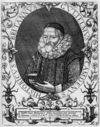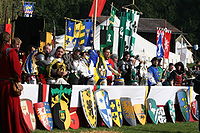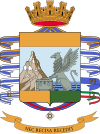Portal:Heraldry
Welcome to the Heraldry and Vexillology Portal!


Heraldry encompasses all of the duties of a herald, including the science and art of designing, displaying, describing and recording coats of arms and badges, as well as the formal ceremonies and laws that regulate the use and inheritance of arms. The origins of heraldry lie in the medieval need to distinguish participants in battles or jousts, whose faces were hidden by steel helmets.
Vexillology (from the Latin vexillum, a flag or banner) is the scholarly study of flags, including the creation and development of a body of knowledge about flags of all types, their forms and functions, and of scientific theories and principles based on that knowledge. Flags were originally used to assist military coordination on the battlefield, and have evolved into a general tool for signalling and identification, particularly identification of countries.
Selected article

The College of Arms, in London, is an office regulating heraldry and granting new armorial bearings. As its name suggests, it is a corporate body (founded 1484) consisting of the professional heralds who are delegated heraldic authority by the Queen for England, Wales and Northern Ireland. (Note that Scotland is not included; that country has its own heraldic authority: Lord Lyon King of Arms and his office.) The college also grants arms to citizens of other Commonwealth countries that do not have their own heraldic authorities. (Canada and South Africa have their own heraldic authorities, the Canadian Heraldic Authority and the Bureau of Heraldry, respectively.) (more...)
Selected biography

William Camden (May 2, 1551–November 9, 1623) was an English antiquarian and historian. He wrote Britannia, the first topographical survey of the island of Great Britain, and Annales, the first detailed historical account of the reign of Elizabeth I of England. In 1597 he was appointed Clarenceux King of Arms to facilitate his research, the post carrying a salary, and the College of Arms at the time being a centre of antiquarian studies. The appointment, however, roused the jealousy of the herald Ralph Brooke, who in retaliation published an attack on Britannia, charging Camden with inaccuracy and plagiarism. Camden successfully defended himself against the charges in subsequent editions of the work. (more...)
Selected flag

The Flags of Puerto Rico represent and symbolize the island and people of Puerto Rico. The origins of the current flag of Puerto Rico, adopted by the Commonwealth of Puerto Rico in 1952, can be traced to 1868, when the first Puerto Rican flag, "The Revolutionary Flag of Lares", was conceived by Dr. Ramón Emeterio Betances and embroidered by Mariana "Brazos de Oro" Bracetti. The exiled Puerto Rican Revolutionary Committee chose the Flag of Lares as their standard. In 1892, the Revolutionary Committee adopted a design modeled after the Cuban flag. The new flag consisted of five equal horizontal bands of red (top and bottom) alternating with white; a blue isosceles triangle based on the hoist side bears a large, white, five-pointed star in the center.
The display of a Puerto Rican flag was outlawed and the only flags permitted to be flown in Puerto Rico were the Spanish flag (1492 to 1898) and the flag of the United States (1898 to 1952). In 1952, the Commonwealth of Puerto Rico declared the flag originally designed in 1892 to be the official flag, but without specifying the tones of colors to be used. The color of the triangle that was used by the administration of Luis Muñoz Marín was the dark blue that is used in the flag of the United States, instead of the original light blue, thus creating a political controversy which has lasted throughout the years. (more...)
Selected picture

Coats of arms displayed on shields and gonfalons, and crests mounted on helmets at a reenactment of a medieval tournament.
Did you know...
- ...that the Italian mountain Cimon della Pala appears on the coat of arms of the Guardia di Finanza (pictured)?
- ...that the English herald Ralph Brooke tricked Sir William Segar into granting a coat of arms to a London hangman?
- ...that the Seal of the Federal Bureau of Investigation was first used on January 1, 1941 and represents the values, standards and history of the FBI and its agents?
- ...that the Flag of Federal Territory, Malaysia, was adopted on May 23, 2006?
- ...that in 2006 Devon County Council first raised the flag of Devon, which was designed by a member of the public in 2002 via an online poll on BBC Devon?
Related portals
|
|
|
Heraldry Web resources
Authorities
- Belgium - The Council of Nobility, Flemish Heraldic Council and Council of Heraldry and Vexillology of the French Community
- Canada - Canadian Heraldic Authority and see also Public Register of Arms, Flags and Badges
- England, Wales, and Northern Ireland - The College of Arms
- Ireland - The Office of the Chief Herald of Ireland
- Netherlands - High Council of Nobility
- Portugal - Instituto da Nobreza Portuguesa
- Scotland - The Court of the Lord Lyon
- South Africa - South African Bureau of Heraldry
- Sweden - National Board of Heraldry, The National Archive
- United States Army - The United States Army Institute of Heraldry
Societies
- Greek Heraldry Society
- The Academy of Heraldic Science Czech republic
- The American College of Heraldry
- The American Heraldry Society
- The Augustan Society
- The Australian Heraldry Society Inc.
- Bulgarian Heraldry and Vexillology Society
- The Center for Research of Orthodox Monarchism
- Cambridge University Heraldic and Genealogical Society
- Chiltern Heraldry Group
- The College of Dracology
- Croatian Heraldic and Vexillologic Association
- The Finnish Heraldic Society
- Fryske Rie foar Heraldyk
- Hellenic Armigers Society
- Guild of Heraldic Artists
- Genealogical Society of Ireland
- Heraldry Research Institute (Japan)
- The Heraldry Society
- The Heraldry Society of Africa
- The Heraldry Society of New Zealand Inc.
- The Heraldry Society of Scotland
- The Heraldry Society of Southern Africa
- The Institute of Heraldic and Genealogical Studies
- The International Association of Amateur Heralds
- Italian Center of Vexillological Studies
- Lancashire Heraldry Group
- Macedonian Heraldry Society
- New England Historic Genealogical Society Committee on Heraldry
- Norwegian Heraldry Society
- Oxford University Heraldry Society
- Polish Heraldry Society
- Polish Nobility Confederation
- Real Academia Matritense de Heráldica y Genealogía - Royal Academy of Heraldry and Genealogy of Madrid
- Romanian Institute for Genealogy and Heraldry
- The Royal Heraldry Society of Canada
- The Russian College of HeraldryThe Russian College of Heraldry
- Serbian Heraldic Society
- Societas Heraldica Scandinavica
- Societas Heraldica Slovenica
- Swedish Heraldic Society
- Ukrainian Heraldry Society
- Royal Association Genealogical and Heraldic Office of Belgium
Vexillology
Software
- Coat of Arms Visual Designer web-based program
- Puncher Heraldry Program
- Blazonry Server - pyBlazon
- DrawShield - creates SVG shield or arms image from blazon
- CoaMaker - web-based tool
- Blazon95 and BLAZONS! 2000, older Windows applications
Texts
- Heraldry, historical and popular : with seven hundred illustrations (1863)
- A Complete Guide to Heraldry (1909)
Other
Wikimedia
The following Wikimedia Foundation sister projects provide more on this subject:
-
Commons
Free media repository -
Wikibooks
Free textbooks and manuals -
Wikidata
Free knowledge base -
Wikinews
Free-content news -
Wikiquote
Collection of quotations -
Wikisource
Free-content library -
Wikispecies
Directory of species -
Wikiversity
Free learning tools -
Wikivoyage
Free travel guide -
Wiktionary
Dictionary and thesaurus
- Portals with triaged subpages from February 2020
- All portals with triaged subpages
- All portals
- Portals with no named maintainer
- Random portal component with more available subpages than specified max
- Random portal component with 16–20 available subpages
- Random portal component with 31–40 available subpages
- Random portal component with 26–30 available image subpages
- Heraldry
- History portals
- Society portals
- Heraldry portal
- WikiProject Heraldry and vexillology











